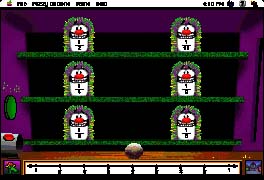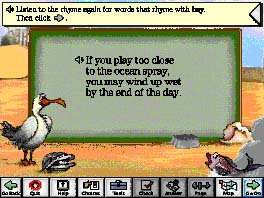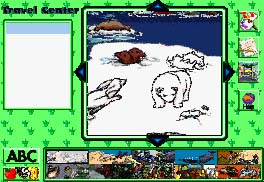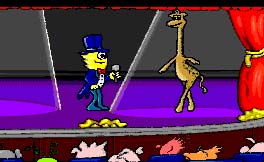Fall 1998, Vol. 10 No. 1
by Debra Radice
SUBJECT AREA: Math
PUBLISHER:
Sunburst Communications, Inc.
(800)321-7511
http://www.nysunburst.com
COST: $79.00
GRADE LEVEL: 3-8
NOTABLE HARDWARE REQUIREMENTS:
Mac: System 7.0 or higher, 8 MB RAM, CD-ROM drive.
Win: Windows 3.1 or higher, 8MB RAM, CD-ROM drive.
DESCRIPTION: Fraction Attraction provides a stimulating
environment where students can explore critical fraction concepts including:
ordering, equivalence, relative size, understanding fractions as representing
distance on a number line, addition and subtraction of fractions, and
"counting on" fractions.
Fraction Attraction opens with Gilda, a cheerful alligator who acts as
a carnival barker, inviting students to participate in one of four familiar
arcade/boardwalk games.
Frac Trac is a representation of the game in which players shoot water
at a target to move race horses from start to finish. In Place Horses, the
student must analyze the fractions/decimals illustrated on the horses'
blankets and predict the finishing order. In Place Jockey, the order of finish
is predetermined, and the student must place the correct number on the horse
to match the finishing order. The game addresses the concept of a
fraction representing a specific distance, as opposed to simply a point,
on a number line. It also introduces students to "counting
on" incrementally with fractions, decimals, and percents.
In Frac-o-Wheel the student must move the ferris
wheel clockwise or counter-clockwise to unload passengers from
the ride. The ferris wheel has between 4-12 chairs. When it is
time to unload a chair, it will flash. The object is to move the chair
to the ground in the fewest number of moves. The student must
fill in a missing component (numerator, denominator, or both)
and select the direction to turn the wheel. This game is designed
to provide multiple representations of a fraction, to introduce
the concept of equivalence, to foster fraction recognition, and
to introduce addition and subtraction with fractions.
Whack-a Frac, the ever-popular "Whack-a-Mole"
game, addresses equivalence of fractions, decimals and percents.
A target fraction/decimal is represented, and the "Fracs" pop
up with a fraction/decimal on their shirts and holding Yes and
No placards. The student must determine if the number on the
shirt equates to the target number and whack Yes or No. The
game can be timed or untimed.

The goal is to knock down the Fuzzy Fracs in order
from smallest to largest in this game of Fuzzy Fracs.
Fuzzy Fracs deals with concepts of ordering and relative
size of fractions, decimals and percents, e.g., Where does one
fraction fall in relation to another fraction? Why is one-half larger
than one-third? This is the game where the object is to knock over
the animals with a baseball to win a prize. Here, the "Fracs"
have fractions/decimals on their shirts, and the student must
knock them over in sequential order, either smallest to largest or
vice versa.
STRENGTHS: Fraction Attraction provides a colorful,
fun and exciting way to learn about fractions.
The non-threatening environment draws students in and keeps their
interest. It is adaptable to students' different learning styles, levels and
needs. Each game has difficulty levels, allowing for individual customization.
Problem-specific diagnostic help is available to
support students as they learn. If a student is having difficulty solving
a problem, the program provides a detailed analysis of the solution.
Another very nice component to this software program is
the clearly written teacher's guide with 22 "very cool"
extension activity worksheets.
WEAKNESSES: As the difficulty level increases,
distractible students may have trouble with the cluttered screen.
SUMMARY: This fun, colorful program helps
students strengthen their understanding of critical concepts related
to fractions. The use of arcade-style games adds humor
and entertainment to a subject many students find overwhelming.
Teachers and parents will appreciate the customizing features
and the quality of the program's instructional design.
Debra Radice is a graduate student in the Department of
Special Education at The College of New Jersey.
Back to the top
by Susan Eckstein
SUBJECT AREA: Reading
PUBLISHER:
Macmillan/McGraw-Hill
(800)442-9685
http://www.mmhschool.com
COST: Single Module $49 - $59 each; Lab Packs $147 - $177 per 5-pack
INTENDED AUDIENCE: Primary Grades
NOTABLE HARDWARE REQUIREMENTS:
Mac: 68030 25 MHz or higher, System 7.1 or later,
QuickTime for Macintosh 2.5, 4.7 MB RAM
Win: 386/33 MHz or higher for Windows 3.1; 486/33 or
higher for Windows 95, 8 MB RAM, Sound Blaster compatible
sound card, speakers
Both: 2X CD-ROM drive, 256 color monitor - 13" or
larger, microphone, printer recommended
EDUCATIONAL GOALS: To strengthen the
understanding of phonograms (word families) and to provide reading
and writing opportunities using this skill.
DESCRIPTION: 'Tronic Phonics is a
comprehensive interactive basal type reading program. Fourteen CD-ROMs
are available, each focusing on 3-4 specific phonograms.
Each lesson targets one phonogram and presents it through a
reading section, a set of instructional phonics activities, and a
story making activity.
In the story "Molly May" children discover words from
the -ay family as they enjoy a story set by the sea.

The reading section is an interactive storybook. The
stories are read by a narrator. The narration speed can be adjusted,
and the text can be underlined as each word is spoken. The stories
are filled with rhymes using the targeted phoneme. The text
is simple, and the stories are fun and loaded with
educational surprises. Students can elect to have words repeated. When
a targeted word is selected, the student is reinforced with
special sound effects. Throughout the story, students can select
"spotlighted" words to learn interesting facts.
The phonics activity first provides practice listening to
the targeted sound. A "key word" is presented, and students
must listen for words that rhyme. The rhymes are also
presented visually to help the students develop spelling patterns.
Incorrect responses are spoken auditorially, and the instructions
are repeated. Correct answers are rewarded with sound effects
and animations. Next, students practice blending/decoding skills
by choosing new letters to join the phoneme to create new words.
Incorrect responses are not blended, and the students are told
that although their answer may rhyme, it is not a real word. The
last phonics activity allows students to write their own rhyme
or sentence and use the record function to hear themselves read
their creation. A help feature is available to provide hints
throughout the phonics activities.
The Make-A-Book section lets students write and
illustrate their own stories or change the existing one. The paint
feature contains numerous drawing tools and colors, as well as
stickers for young authors. They can click on the speaker to have
their story read aloud.
STRENGTHS: 'Tronic Phonics provides students with
many opportunities to practice targeted sounds. The lesson format
is uniform throughout the series, minimizing instruction time.
The tool bar is "child-friendly," and students can make lots of
independent choices. Being able to adjust the narration speed is a
helpful feature for children with reading difficulties.
Graphics are large and colorful, and choices become
"spotlighted" as the cursor passes over them for easy identification.
Instructions are clear and concise.
The package comes with a soft cover book of the story,
so students can add them to their "library" of knowledge.
WEAKNESSES: Students must be able to use a mouse.
SUMMARY: 'Tronic Phonics is an excellent series
for teaching reading through phonograms. It goes beyond
most phonics software by providing opportunities for students
to experience word families in context, i.e., they first play
with interactive storybooks which utilize the targeted phonogram,
and after they practice blending/decoding, they can write and
illustrate their own stories using the phonograms they just learned.
This provides a nice bridge between phonics skills and a
whole language approach to reading instruction. Together the 14
CD-ROMs offer a comprehensive package for the teaching of
reading in the primary grades.
Susan Eckstein is a graduate student in the Department of
Special Education at The College of New Jersey.
Back to the top.
By Lauren R. Golden
SUBJECT AREA: Writing and Illustrating
PUBLISHER:
The Learning Company
(800) 685-6322
http://www.learningco.com
COST: $24.95
INTENDED AUDIENCE: Grades K - 2
NOTABLE SYSTEM REQUIREMENTS:
Mac: 68030/25 MHz or better, 8 MB RAM with 4 MB
available (5 MB available for Power Macintosh), 2X CD-ROM drive,
256-color monitor, System 7.1 or higher.
Win: 486 DX/33 MHz, 8 MB RAM, 2X CD-ROM
drive, Windows 3.1 or higher, Windows-compatible sound card,
256 color VGA monitor.
DESCRIPTION: Paint, Write &
Play! is a program that encourages young children to write and illustrate
their own stories. The main screen opens to The Village. From
here students can visit three centers: The Travel Center, the Art
Studio and the Writing House.
Students choose backgrounds, such as this Artic Scene, in the Travel
Center.
The Travel Center provides story ideas for young writers.
Students can explore ten different places such as home
scenes (e.g., bedroom, basement, living room, etc.) and
environmental scenes (e.g., the Arctic and Africa). When students come across
a word they do not know, a simple mouse click provides the
correct pronunciation and a definition. If they like, they can add
the word to their "personal word list."
In the Art Studio students can illustrate their stories. They
can use the clip art provided or create their own illustrations.

For illustrating stories, students can choose
from fun color palettes, such as this selection
representing "sunny day" colors.
The clip art consists of environmental backdrops and characters.
If students want to create their own illustrations, the
program provides paint brushes, stamps and patterns. The
program pronounces the names of the colors when the mouse passes
over them.
Students compose their stories in the Writing House.
Students can use their personal word list and/or illustrations as a
beginning point, or they can just begin to write. Writers can view the text
as it will appear underneath each illustration, or they can view
the layout of the entire story using a storyboard. They can listen
to their stories being read aloud by the program.
STRENGTHS: The Travel Center environments are
stimulating and can help expand students' imaginations. Each
environment provides its own unique vocabulary. The sound effects
and animations are entertaining and engaging without being
distracting. The Art Studio provides an extensive choice of 48
"kid colors," such as grape, sunshine and cotton candy.
The program provides auditory feedback by reading
aloud students' stories. Teachers can customize the program to
correspond to classroom assignments by controlling the length of
the story, the vocabulary and the layout.
SUMMARY: Paint, Write &
Play! is a fun, easy-to-use program that taps into children's imaginations
to help them
create and illustrate stories. Pick-and-click word lists help early
writers add words to stories without typing, and the
text-to-speech feature lets students hear their stories read aloud.
Lauren R. Golden is a graduate student in the Department of
Special Education at The College of New Jersey.
Back to the top.
by Francine Kartzman
SUBJECT AREA: Expressive Language
PUBLISHER:
Laureate Learning Systems
(800)562-6801
www.llsys.com
COST: $125 Mac/Win CD-ROM (available January
1999), Mac disks, DOS disks
INTENDED AUDIENCE: Children ages 2-6
with developmental disabilities, language-learning
disabilities, physical and visual impairments, and autism
NOTABLE HARDWARE REQUIREMENTS:
Mac CD-ROM: System 7.5 or later, Power PC (some
68040 processor models), 8 MB RAM, 4X CD-ROM
Win CD-ROM: Pentium 90 MHz or higher, Win 95 or later,
16 MB RAM, Windows compatible sound card, 800 x 600
SVGA graphics monitor
Mac disk version: System 7.5 or later, minimum 68040
processor, 8 MB RAM
DOS disk version: Sound Blaster card (or 100% compatible)
All: Microphone, 13" or larger color monitor
OPTIONAL HARDWARE: Touch screen, single switch
EDUCATIONAL GOALS: To encourage children
to practice a variety of vocalization skills and to experiment
with the duration, pitch, and volume of their utterances.
DESCRIPTION: TalkTime with
Tucker is a voice activated software program. Tucker, an animated
character, moves
and talks when children talk or make sounds into a microphone.
This program does not require precise, accurate speech input.
Almost any utterance produces an appropriate response.

Tucker commands the animals to perform tricks
when children make sounds in the Amazing Animal Show.
For non-vocal children, single switch input activates Tucker.
This encourages turn-taking and gives them the experience
of participating in conversation.
Five adventure activities accommodate a range of children
at different functioning levels:
- In On Stage, Tucker acts as Master of Ceremonies of
the Amazing Animal Show. Cause and effect and turn-taking
are targeted as any sound that children make will make
an animal perform a stunt.
- Children imitate animal sounds in
On the Farm. As each animal makes its sound, children repeat it, and the
animal puts something in Tucker's wheelbarrow.
- In A Walk in the Woods, children are encouraged to
increase the length of their vocalizations. Children make
things change, such as caterpillars, birds' eggs, and tadpoles.
The longer the vocalization, the more that happens on screen.
- Children experiment with pitch and volume in
Fantasyland. Mystical characters block Tucker's path to the castle.
Children must speak louder or softer to get by them.
- Casey the Chameleon asks open-ended questions in
Let's Talk with Casey the Chameleon. In this activity, which
is designed to encourage natural communication
exchanges, Casey responds by transforming into the object he is
talking about.
STRENGTHS: TalkTime with Tucker can be
individualized for children with a broad range of disabilities. The
sensitivity
of the microphone can be adjusted, as can the amount of
response time required, the length of time children must speak, and
how quickly the program responds when children stop speaking.
The program also contains an invaluable recordkeeping tool
that tracks children's progress. This log can be printed or cut
and pasted into a wordprocessing document so that individual
notes can be added.
WEAKNESSES: Some of the speech output may
be difficult for children with hearing impairments to understand.
SUMMARY: TalkTime with Tucker is visually
appealing, imaginative and colorful, but at the same time the screen
remains uncluttered. The activities are easy to use and engaging
for young children. The customizable options and
recordkeeping features make this program a good choice for
speech/language specialists to use for encouraging expressive language in
young children.
Tiger's Tale
This new program from Laureate Learning Systems stimulates
language production by encouraging children to talk for a
Tiger who has lost his voice. Preschool and elementary
students alike will delight in recording their voices to create their
very own movies.
Francine Kartzman is a Speech/Language Therapist who completed
a graduate course in Assistive Technology at The College of New Jersey.
Back to the top.
by Theresa R. Lupo
SUBJECT AREA: Switch Training, Cause and
Effect, Early Scanning
PUBLISHER:
Inclusive Technology available from IntelliTools
(800)899-6687
www.intellitools.com
COST: $49.95 each for disk version or $180.00 for the
4-program bundle on CD-ROM
INTENDED AUDIENCE: Switch users
EDUCATIONAL GOALS: To develop the concepts
of cause and effect, scanning, turn-taking, and switch training.
NOTABLE HARDWARE REQUIREMENTS:
Mac: LCIII or better, System 7 or higher, 8MB RAM,
CD-ROM drive for bundle.
Win: Windows 3.1 or higher, 8 MB RAM, Win
compatible sound card/speakers, SVGA monitor, CD-ROM drive for bundle
ACCESS OPTIONS:
- mouse operation
- single/two switch
- touch screen
- Concept Keyboard
- IntelliKeys
DESCRIPTION: This series provides switch users with
four lively and colorful programs for entertainment and
switch training.
In Pictures users develop awareness of cause and effect.
They are prompted to press the switch to build common objects
one click at a time. Each click is followed by the addition of an
item to the scene. When the task is complete, users are rewarded
with a lively and amusing animation.
Patterns builds upon cause and effect awareness by
encouraging users to build 10 geometric patterns by pressing the
switch. This activity has three levels of complexity built in.
Upon completion of the pattern, students are rewarded with
vibrant color changes, movement and music. Patterns
offers a variety of color schemes, including black and white, vivid,
metallic,
pastel, and monochrome. Pattern complexity and movement speed
may also be customized. The black and white setting may be
particularly helpful for users with low vision.
Scenes promotes turn-taking as users add new elements
to familiar scenes. Completed scenes are rewarded with
animated sequences. Customized switch colors let each user know
whose turn it is.
Opposites introduces users to early learning concepts
through simple scanning. The blue monster leads users to explore
big/little, up/down, in/out, open/closed and hot/cold through a
variety of scenes. Comical animation rewards correct choices. Two
to four objects appear on the screen. After several
successful presentations of 2 objects, the program will
automatically introduce 3, then 4. Opposites
allows scan speed and repeat rate to be customized, as well as allowing
auditory, text cuing or both.
STRENGTHS: Probably the most exciting feature
for teachers is the ease with which these programs can be
customized. They can change speed and response time, number
of switch clicks, text/speech or both, and which concepts will
be practiced, all from one readily accessible menu. The
scene's background color, switch cap color and even scan box color
can be customized. The error indicator, an animated "Uh-uh,"
from the blue monster, may also be turned off. Customized
settings can be saved for individual users. Clip art is provided so
flash cards or classroom materials can be created using the
characters and objects in the programs.
Students may enjoy the simple scenes and clear feedback
for both correct and incorrect responses. Users are prompted to
click the appropriate switch, first with a picture of the switch, then
an animated picture and finally an auditory reminder. Users
may also view a word or picture menu for selecting their activities.
WEAKNESSES: Activities from the menu cannot
be selected with a switch; a mouse click is required.
SUMMARY: These four simple programs teach cause
and effect, switch use and early scanning through a variety
of activities. The clear, immediate feedback, prompting
schedule and amusing animation are sure to motivate students to
build switch use skills. Teachers will enjoy the ease with which
they can modify the programs to meet individual user needs.
Theresa R. Lupo is an alumna of the graduate program in
Special Education at The College of New Jersey.
Back to the top.
Back to index...





